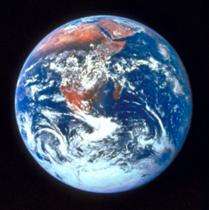Probing Question: What is a Near Earth?

In the 1997 movie "Contact" (based on the novel by Carl Sagan), actress Jodie Foster plays an astrophysicist devoted to SETI -- the Search for Extra-Terrestrial Intelligence. Despite doubting colleagues, she vigilantly monitors signals from radio telescopes aimed at thousands of nearby sun-like stars, hoping to receive a message from alien life forms. While the large dish telescope in the movie is real (the movie was filmed on location at Arecibo Observatory in Puerto Rico), the contact isn't. So far, the skies remain silent.
Are we alone in the universe? The more basic question may be whether a planet like ours exists, said Jason Wright, assistant professor of astronomy at Penn State.
"Within the next few years we’re going to hear the announcement that someone has found an Earth-like planet," he predicted. Information gathered over the years about other solar systems has made Wright optimistic that such 'terrestrial planets' -- rocky and one half to twice the size of Earth -- exist around other Sun-like stars.
To locate such planets, astronomers are looking not for life itself but for the conditions that favor it, said Wright. "Near Earths" -- planets with similar conditions to Earth -- would have to fall within the narrow region of orbit called the "habitable zone" or more whimsically, "The Goldilocks Zone," since it would have to be not too close to a star, and not too far, but just right. The proper distance from a star is the critical condition for a planet to maintain liquid water and possibly support life.
The search started in our own solar system, Wright explained. "But even the likeliest candidate, Mars, was too cold." The other planets in our solar system proved to be even less hospitable. However, a couple of decades ago, Penn State's Alex Wolszczan was among the first to find planets outside our solar system. Since then, more than 400 planets have been found. To this point, most of them resemble Jupiter -- gaseous giants almost certainly devoid of life.
But some recent discoveries have astronomers believing we won’t have to wait much longer to see a Near Earth. "It’s not that Near Earths don’t exist," he said, "but rather that the instruments astronomers use still aren’t quite powerful enough to easily detect small, rocky planets."
The search method has two parts. First, telescopes are used to spot "transits" or instances when distant planets flash across a star. When planets transit, they block light from their host star, making it dimmer, said Wright. "The amount of dimming tells us their size." The planets most likely to be Near Earths are then measured for star "wobble," an indication of the gravitational pull the planet has on its star. The velocity of the wobble reveals the planet’s mass, which, when combined with its size, gives investigators its density, which allows them to guess at its overall composition.
Large planets that are closer to their suns are easier to spot because they cause their stars to wobble at a higher velocity, Wright explained. They also are less likely to maintain water, so astronomers such as David Charbonneau of Harvard are trying to find smaller, cooler candidates. GJ 1214b, Charbonneau’s recent find, has renewed interest in the hunt, because it might be what Wright calls a "water world." Still, GJ 1214b is six times the size of our own planet and far too hot to support life. In order to find prospects closer to Earth’s mass, Wright said a better spectrograph -- an instrument that can detect more subtle wobbles -- is needed. Meanwhile, a NASA project called the Kepler Mission continues the search, surveying the Milky Way galaxy for habitable planets.
Once such planets are discovered, said Wright, the next step will be to scrutinize them for signs of life. Astronomers won’t be looking for Hollywood Martians, however, but for "scum -- the sticky stuff of primitive life" which when studied could yield insights into how life evolved here on Earth.
Provided by Pennsylvania State University




















